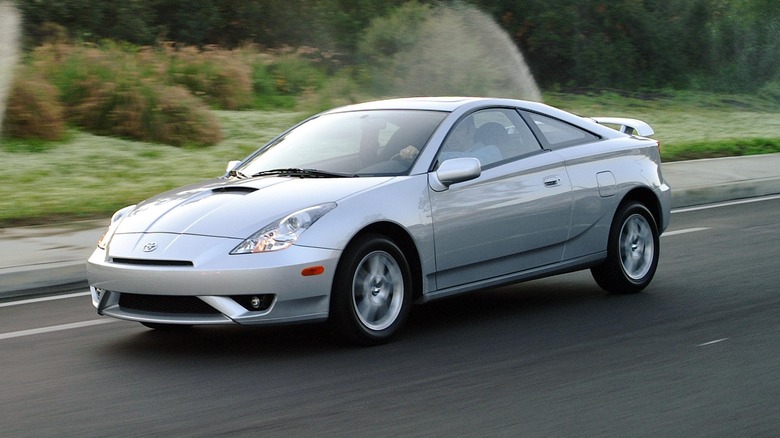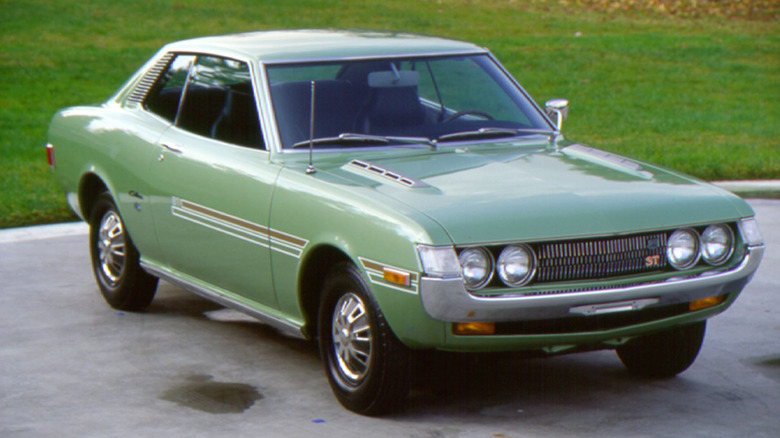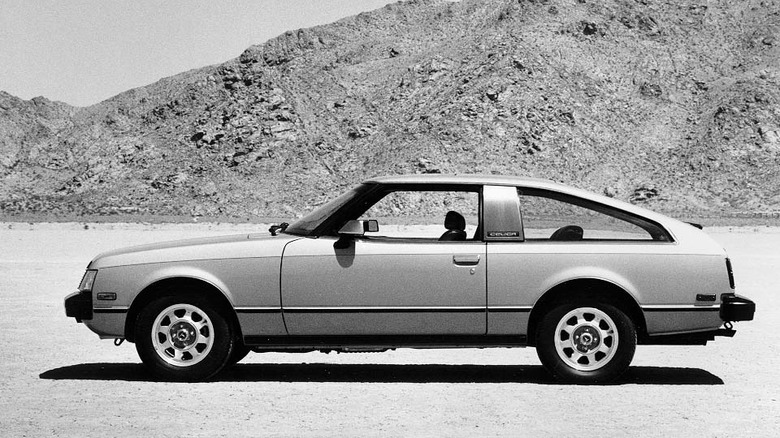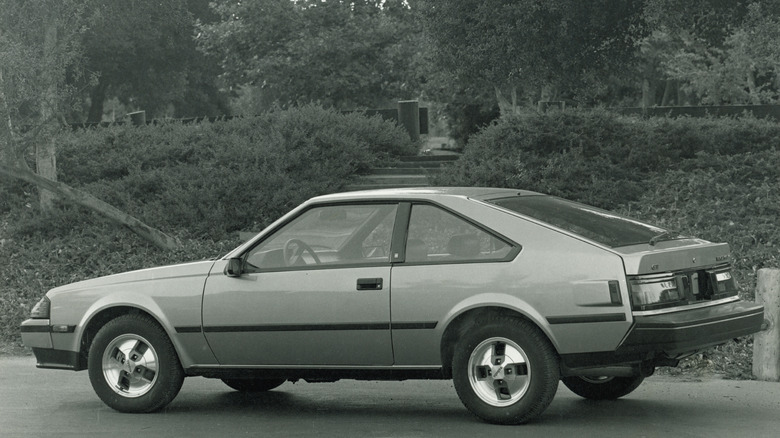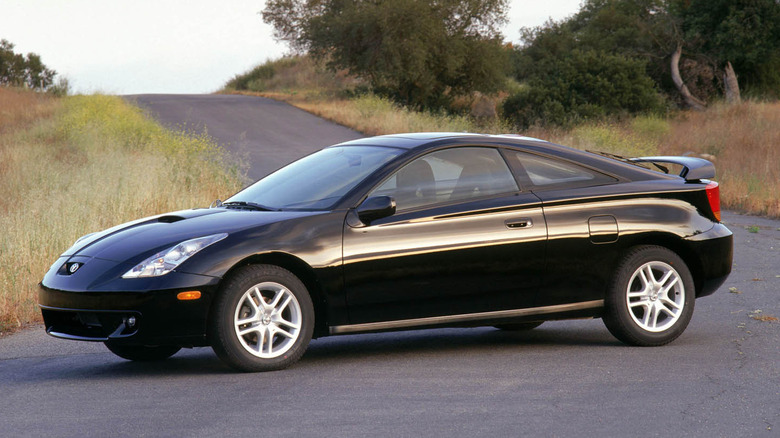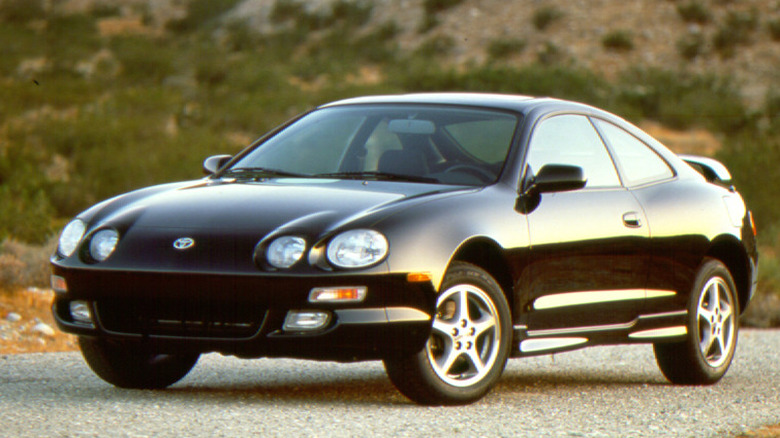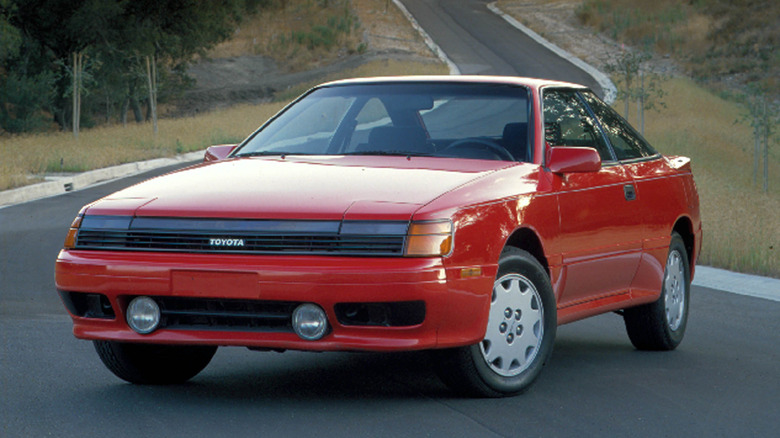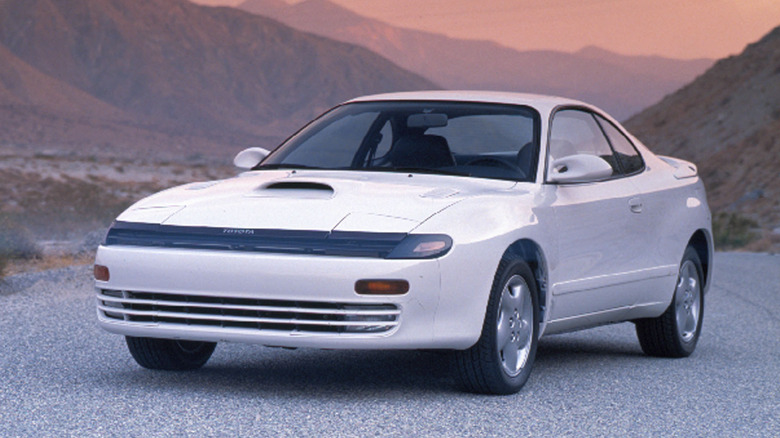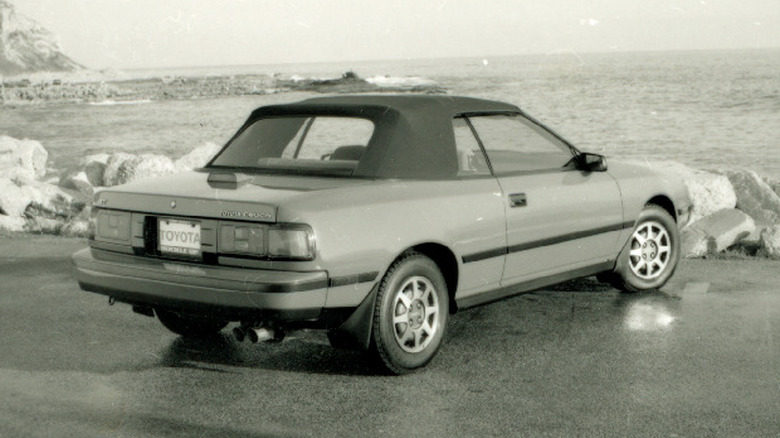Every Generation Of Toyota Celica, Ranked From Slowest To Fastest
While it lasted, the Celica was one of Toyota's long-running models, spanning seven generations and over 30 years of production. In that time, over 4 million Celicas were produced worldwide. If it hadn't been discontinued in the early 2000s, the Celica would be amongst the longest-running continuously sold Toyotas in the United States today. Alas, the Celica's sales dipped during its last few years. The sales slump, combined with changes in emissions standards, led to the demise of the Celica at the end of its seventh generation. Recently, rumors are everywhere about the potential return of the Celica, but Toyota hasn't confirmed any details just yet. Thankfully, that won't stop us from looking back with a bit of nostalgia and breaking down which Celica was the fastest.
Before we jump in, a few notes about our methodology for all you Celica enthusiasts. For starters: fastest is determined here by top speed. When top speed is unavailable, acceleration from zero to 60 mph is used — and we've included it for a bit of context — but speed takes top priority. We're also including the Celica Supra variants on this list as a part of the Celica family. Once they depart from the Celica family and venture off as Supra models only, they no longer count in the rankings. Also, we're sticking to US models only here. Foreign market cars like the Celica GT-Four are certainly rare collectibles worth lusting after, but they don't get a spot on this list.
7. First generation (1971 – 1977)
While it wasn't very fast, the first Celica was still pretty special. It was affordable, stylish, and enjoyable to drive. The 1971 Celica ST was powered by a four-cylinder 1.9 liter single overhead cam engine that made 108 horsepower and 117 lb-ft of torque. When it was tested by Road and Track, the first Celica took 13.5 seconds to accelerate from zero to 60 miles per hour. Not astonishingly fast by even the standards of the day, but things would soon get better.
In the mid-'70s, a new Celica GT was introduced along with some refreshed body styles. It was technically still part of the first generation but now powered by a 2.2-liter engine that produced 96 horsepower and 120 lb-ft of torque. When Road and Track tested it again in 1976, zero to 60 mph took just 12.2 seconds. The top speed for the new model was 108 miles per hour. While the Celica had lost a little bit of horsepower, it's believed that the increased torque accounted for the improvement in acceleration.
6. Second generation (1978 – 1981)
The introduction of the second-gen Celica brought with it new styling and, eventually, a new engine. When it first arrived in 1978, it carried over with the same 2.2-liter engine, but in 1979, the Celica Supra was introduced and with it came a 2.6-liter inline-six-cylinder engine. It was paired with a five-speed manual transmission as standard, with an available four-speed automatic. It produced 110 horsepower and 136 lb-ft of torque from the factory. The Celica Supra was longer than the standard Celica, but it still wore a Celica badge, so we've included it here.
When Car and Driver tested a Celica Supra back in 1979, it did the sprint to 60 mph in 11.2 seconds. Getting across the quarter-mile marker took 18.4 seconds, and the Celica Supra had a reported top speed of 110 miles per hour. The Supra would go on to great success on its own, but the launch via the Celica brand was a strong starting point. Before the end of the second generation, the Celica Supra eventually upgraded to a 2.8-liter engine with 116 horsepower and 145 lb-ft of torque. Details on the 1981 Celica are slim, with few reliable sources reporting on the acceleration and top speed, but with the mild increases in power, performance was likely similar.
5. Third generation (1982 – 1985)
The third generation of Celica was available, like its predecessors, in a number of different configurations. It could be had as a Liftback or as a Sport Coupe and in GT or GT-S trims. However, the higher-performance Supra still sported the Celica name -– helping to raise the performance bar for the Celica. The standard Celica models in 1982 used a 2.4-liter four-cylinder engine that produced 96 horsepower. That was enough power to push it through the quarter mile in 18.2 seconds, making it ever-so-slightly faster than the second-gen model, but the Celica Supra was much more powerful.
The 1982 Celica Supra was powered by a 2.8-liter inline-six-cylinder engine that produced 145 horsepower and 155 lb-ft of torque. When Car and Driver took one to the test track, it went from zero to 60 mph in 8.8 seconds – shaving over two seconds off the previous generation's time. The quarter-mile was dealt with in 16.7 seconds, and the top speed clocked in at 115 miles per hour – both were significant performance increases over the second-gen Celica. In 1984, the Celica and the Supra parted ways, getting their own nameplates, but they both continued being built in the same styles through 1985.
4. Seventh generation (2000 – 2005)
It might seem a bit early to spot the final generation of the Celica on the list, but it turns out that it wasn't the fastest – at least not when it comes to top speed. Under the hood, the 2000 Celica GT had a 1.8-liter four-cylinder engine that produced 140 horsepower and 125 lb-ft of torque. The upgraded engine, however, was significantly more powerful. It was also a 1.8-liter four-cylinder engine, but it put out 180 horsepower and 133 lb-ft of torque.
During testing, the 2000 Celica GT-S went from zero to 60 miles per hour in 6.6 seconds, making it the quickest Celica around, but not the fastest — quick being a measure of acceleration, fast being a measure of top speed. Top speed claims from Toyota are difficult to track down for the final generation of the Celica, but when Car and Driver tested a modified TRD (Toyota Racing Development) version of the GT-S back in 2000, it was limited to 129 miles per hour. It's worth noting that the modified GT-S was rated slightly higher than the standard model at 194 horsepower, but their acceleration numbers were similar. The standard and the TRD-modified versions of the seventh-generation Celica went from zero to 60 mph in 7.2 seconds and 7.5 seconds, respectively.
3. Sixth generation (1994 – 1999)
In 1994, when Toyota introduced the newest Celica, circular headlights rather than pop-ups were all the rage. The new model brought big changes in style, but power was pretty similar to previous Celicas. Like the fifth-gen model (more on that in a bit), the sixth-generation Toyota Celica was powered by a few different engines. Base models got a 1.8-liter four-cylinder engine that put out 110 horsepower, while GT trims got a 2.2-liter powerplant that produced 130 horsepower –- the same as the previous generation.
Unfortunately, the powerful all-wheel-drive All-Trac was no longer available for the sixth-generation Celica so top speed and acceleration dropped off in a big way compared to previous years. Zero to 60 mph was quoted at 8.3 seconds, and the top speed was 131 miles per hour with the more powerful GT model. When MotorWeek tested a Celica Convertible in 1995, it went from zero to 60 miles per hour in a relatively underwhelming 9.1 seconds.
2. Fourth generation (1986 – 1989)
In 1986, during the change from third- to fourth-generation models, the Celica went from a rear-wheel drive configuration to front-wheel drive. Along with the change to front-wheel drive, the top Celica GT-S models got a new 2.0-liter dual-overhead cam four-cylinder engine that produced 136 horsepower and 125 lb-ft of torque. The base models got a single-overhead cam engine that only put out 97 horsepower – just one hp more than the third-gen models. With the drop in horsepower and the switch to front-wheel drive, it would be easy to assume that the fourth-generation Celica was slower than the outgoing third-gen Celica Supra. But when MotorWeek tested the Celica GT-S in 1986, it went from zero to 60 mph in 8.7 seconds –- one-tenth of a second faster than the old Celica Supra.
The fourth-gen Celica didn't stop there. It continued to increase performance rapidly with the debut of the Celica All-Trac Turbo in 1988. Powered by a turbocharged 2.0-liter four-cylinder engine, the All-Trac Turbo put out 190 horsepower and 190 lb-ft of torque – big numbers for the time and much more than any previous Celica. As the name suggests, the All-Trac Turbo put power to the ground via all-wheel drive, increasing performance, especially from a launch. In Car and Driver testing, zero to 60 mph took just 7.3 seconds, with the All-Trac Turbo crossing the quarter mile in 15.6 seconds on its way to an impressive top speed of 135 miles per hour.
1. Fifth generation (1990 – 1993)
The fifth-generation Toyota Celica made some serious styling changes. It dropped the hard angles that characterized Celica styling for the first four generations and went for a curvier look. It also got a small bump in performance. Base ST models got a 1.6-liter four-cylinder engine that produced 103 horsepower, while the GT models got a 2.2-liter four-cylinder that produced 130 horsepower.
The All-Trac made the return for 1990, still being powered by a turbocharged 2.0-liter four-cylinder engine, but this time around, it was making 200 horsepower and 200 lb-ft of torque. For speed, it was essentially tied with the previous-generation model, capable of sprinting from zero to 60 mph in 7.3 seconds. Since the fifth-generation Celica has been out of production for over 30 years, it's difficult to find accurate top-speed ratings, but sources say it ranges between 121 miles per hour and 140 miles per hour. These estimates, combined with the higher horsepower rating compared to the fourth-gen model, give it a slight edge and the top spot on our list as the fastest Celica.
Methodology
As previously noted, the ranking of Celica generations here is based on top speed. Acceleration is noted, and while it is important, that's not how we cut this one up. In some cases, claimed top speed is the only available number but an as-tested top speed was used where available. Top speed and acceleration numbers were sourced from various reputable automotive outlets with long histories of accurate, instrumented testing. Documents sourced directly from Toyota were also used to confirm power ratings, engine specs, and details about the various Celica generations.
